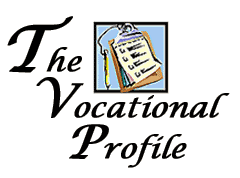Lesson 2: Rehabilitation: A Case Study Approach (Developing a Vocational Profile)
Attention

Learning Outcomes
Upon completion of this lesson's material, students will be able to:
- Identify the components of a Vocational Profile
- Comprehend how each component provides information that impacts an individual with disabilities in an employment setting.
Teaching
The key to understanding vocational aspects of disabilities, is understanding the consumers "Vocational Profile" or Comprehensive Assessment of Rehabilitation Needs. In the Vocational Rehabilitation (VR) world, we refer to this as CARNS - the Comprehensive Assessment of Rehabilitative Needs. The Vocational Profile components that we review include:
- Age at onset of disabling condition
- Current age
- Economic factors - including source of income from wages earned as well as other sources such as Supplemental Security Income/SSI, Social Security Disability Income/SSDI, Unemployment Insurance/UI, & family.
- Severity of disability including impact on function and limitations
- Gender and ethnicity
- Education and vocational background
- Psychological and motivational factors
- Work History
- Skills and knowledge
- Psychosocial adjustment to disability
- Living situation
- Social functioning
- Disability
Vocational Aspects of Disabilities are learned in the context of this vocational profile and how this profile fits with the employment systems in the community. Community based employment services are provided based on an understanding of this profile. Each individual vocational profile comes from the experience and history of that individual within the workforce development systems discussed last week.
It is important that you, as a MHRT/C be responsible for understanding the Vocational Profile as it relates to the consumers employment service plan, and any work you do with that consumer supporting them in finding employment.
This vocational profile or case study approach is one part of the holistic approaches to providing effective and sustainable rehabilitation services to individuals with disabilities. This is one of the 10 components of Recovery that will be discussed later in the class.
Studying case information about consumers who are seeking an employment outcome gives a practical experience to learning how to assist individuals with disabilities entering the workforce. You will find vocational analysis material in the Dictionary of Occupational Titles http://www.occupationalinfo.org including job descriptions and corresponding tasks, aptitudes and functions. This system of job analysis and categorization has been used by The Social Security Administration and the rehabilitation profession since the Rehab Act of 1973. The United States Department of Labor has replaced this job categorization with O*Net http://online.onetcenter.org which is updated on a regular basis. Onet has labor market information for identifying emerging careers and industries and is a good resource for understanding occupations The "Your Next Move" section is a good tool for identifying a persons Holland cods to assist in discovery appropriate career paths.
It is important to become familiar with the O*Net system as this is the current system used by the Department of Labor for labor market research which you will use in the job development function in this course and in the community. In any event, as a case manager the consumer you work with will be looking at work. The better you understand how this assessment is done the better you can educate the consumer and others who are responsible for job development.
Click HERE to visit the O*Net Resource Center Interest Profiler Short Form
Reading Assignments and/or Document/Internet Web site Review:
- Briefly review the content of the Dictionary of Occupational Titles at the O*Net site
- Working on Purpose: 6 Steps to Employment and a Framework for Planning
- Road to Recovery - Employment and Mental Illness (NAMI)
Assessment
Lesson 2 Discussion (For online course only)
Share your Thoughts about the Road to Recovery Document written by NAMI. What insights did this document provide for you? How will it influence your approach to future vocational work with clients?
Lesson 2 Quiz
- List the components of a vocational profile (found in this lesson) and describe how understanding each component will impact the work you do with this client to obtain employment and maintain employment.
- Complete the O*Net Interest Profiler Short Form for yourself and write a brief summary of your results and your reaction to your results. Were you surprised by the outcome? Explain why or why not.
Lesson 2 Assignment
Create a written document about the reasons why it is important to gather CARNS information as part of developing a thorough vocational profile prior to developing vocational goals and plans. Write your document as if you were explaining this process to client. Your explanation should be clear and provide enough information for the client to make an informed decision on the process. It must reflect a deep knowledge on your part of the importance of this information in vocational planning. Submit the document through the Blackboard Lesson 2 Assessment.